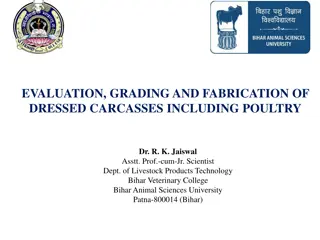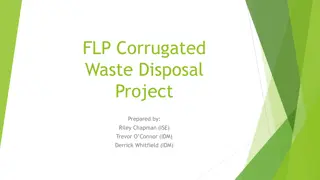On-Site Burial for Carcass Disposal: Methods and Environmental Impacts
Explore the process of carcass disposal through on-site burial, covering topics such as trench burial, site selection, construction and design considerations, environmental impacts, and a comparison with other disposal methods. Learn about key factors influencing on-site burial, including soil properties, trench size, site construction, and potential environmental consequences like air and water quality issues. Understand the advantages and challenges associated with on-site burial as a method for managing animal mortalities.
Download Presentation

Please find below an Image/Link to download the presentation.
The content on the website is provided AS IS for your information and personal use only. It may not be sold, licensed, or shared on other websites without obtaining consent from the author.If you encounter any issues during the download, it is possible that the publisher has removed the file from their server.
You are allowed to download the files provided on this website for personal or commercial use, subject to the condition that they are used lawfully. All files are the property of their respective owners.
The content on the website is provided AS IS for your information and personal use only. It may not be sold, licensed, or shared on other websites without obtaining consent from the author.
E N D
Presentation Transcript
Carcass Disposal On-Site Burial
On-Site Burial Excavated trench or pit Decomposition Heat Length of time required varies Species and size Total volume Soil characteristics Settlement of the burial site Additional backfill Carcass Disposal: On Site Burial Just In Time Training
Burial Types Trench burial Daily mortalities Trapezoid or vertical pits Inexpensive Convenient Mass burial Large numbers of animal mortalities Trapezoid pits with liners More expensive and time consuming Carcass Disposal: On Site Burial Just In Time Training
Site Selection Soil properties Texture and permeability Construction of the site Slope of land Depth of water table and bedrock Location of the site Proximity to water sources or public areas Accessibility Projected future use of the site Carcass Disposal: On Site Burial Just In Time Training
Construction and Design Site size/area Depends on species, age/size, quantity Trapezoid shape pits 42 cubic feet per: 1 adult bovine OR 5 pigs/sheep OR 40 chickens Liners to minimize seepage Caution during excavation Carcass Disposal: On Site Burial Just In Time Training
Construction and Design Trench size 4-8 feet deep 6 feet wide Two large carcasses side by side May include liners Clay may be used as a base layer Vent large carcasses Settlement during decomposition May need additional backfill Carcass Disposal: On Site Burial Just In Time Training
Environmental Impacts Air quality Odor Water quality Leachate Gases Methane, carbon dioxide, hydrogen sulfide Scavengers Carcass Disposal: On Site Burial Just In Time Training
Comparison With Other Disposal Methods Advantages Quick, easy, inexpensive Equipment generally readily On-site; limited transportation Disadvantages Large areas of land Difficult in wet and cold weather conditions Environmental impacts Public opposition Carcass Disposal: On Site Burial Just In Time Training
Regulations and Monitoring Consult State regulations Sites highly regulated Depth, width, length, max size Environmental impact Groundwater monitoring Surface water sources Air quality/odor Record site GPS location Carcass Disposal: On Site Burial Just In Time Training
Biosecurity Biosecurity Personal protective equipment (PPE) Movement control Cleaning and disinfection Site security Unauthorized persons Log book Warning or restriction signs Site security personnel Carcass Disposal: On Site Burial Just In Time Training
Personnel Safety Safety Issues Physical demands Long hours Response activities Psychological impact Weather conditions Carcass Disposal: On Site Burial Just In Time Training
Resources for Carcass Disposal USDA Foreign Animal Disease Preparedness (FAD PReP) Guidelines: Disposal http://www.aphis.usda.gov/animal_health/emrs/nahems .shtml Carcass Disposal: A Comprehensive Review. USDA and Kansas State University https://krex.k-state.edu/dspace/handle/2097/662 Carcass Disposal: On Site Burial Just In Time Training
Acknowledgments Development of this presentation was by the Center for Food Security and Public Health at Iowa State University through funding from the Multi-State Partnership for Security in Agriculture Authors: Melissa Lang BS; Glenda Dvorak, DVM, MPH, DACVPM























